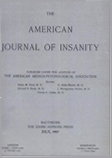THE EMPIRICAL DETERMINATION OF CERTAIN SYNDROMES UNDERLYING PRÆCOX AND MANIC-DEPRESSIVE PSYCHOSES
Abstract
(1) A technique, based upon Spearman's tetrad difference criterion, has been evolved for the empirical determination of the syndromes of psychiatry.
(2) This technique has given in a purely empirical manner eight syndromes and their constituent symptoms.
(1) The Syndrome of Cognitive Defect which is positively related to præcox conditions but, negatively, to manic-depressive.
(2) The Catatonic Syndrome, probably the inhibitory phase of dementia praæcox.
(3) The Uninhibited or Kinetic Syndrome, probably the excited phase of dementia præcox.
(4) The Non-Euphoric Manic Syndrome, which is probably also a phase or form of dementia præcox.
(5) The Euphoric Manic Syndrome, which is probably the underlying condition in the manic form of manic-depressive insanity.
(6) The Delusional Hallucinatory Syndrome, also a factor in dementia præcox.
(7) The Syndrome of Constitutional Hereditary Depression, which indicates an hereditary factor that attacks the controlling mechanism of emotional life or heightens emotivity, but leaves the cognitive general factor untouched.
(8) The Syndrome of Retarded Depression, which is not as yet clearly differentiated.
(3) Reasons are given for regarding these syndromes as neurological defects of a definite nature.
(4) The measures used in the determination of the general factor can now be applied to the diagnosis of the above syndromes. The development of a procedure for doing this in a definite and simple manner is now in progress.
Access content
To read the fulltext, please use one of the options below to sign in or purchase access.- Personal login
- Institutional Login
- Sign in via OpenAthens
- Register for access
-
Please login/register if you wish to pair your device and check access availability.
Not a subscriber?
PsychiatryOnline subscription options offer access to the DSM-5 library, books, journals, CME, and patient resources. This all-in-one virtual library provides psychiatrists and mental health professionals with key resources for diagnosis, treatment, research, and professional development.
Need more help? PsychiatryOnline Customer Service may be reached by emailing [email protected] or by calling 800-368-5777 (in the U.S.) or 703-907-7322 (outside the U.S.).



